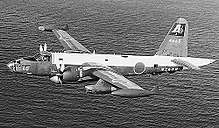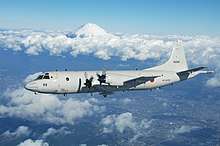Air Patrol Squadron 3 (JMSDF)
Air Patrol Squadron 3 (第3航空隊, daisankoukuutai) (also referred to as VP-3 or Fleet Air Squadron 4) is a unit in the Japan Maritime Self-Defence Force. It is a part of Fleet Air Wing 4 and is based at Naval Air Facility Atsugi in Kanagawa prefecture.[1] It is equipped with Kawasaki P-1 aircraft.
| Air Patrol Squadron 3 | |
|---|---|
| 第3航空隊 | |
.jpg) Squadron 3 Kawasaki P-1 | |
| Active | 1 September 1961 |
| Country | |
| Branch | |
| Part of | Fleet Air Wing 4 |
| Garrison/HQ | Naval Air Facility Atsugi |
| Nickname(s) | Sea Eagle |
| Aircraft flown | |
| Patrol | P-1 |
History
Founding and early history

The squadron was founded on September 1, 1961 at Kanoya Air Base in Kagoshima Prefecture with the founding of the Fleet Air Force on the same date. It was equipped with nine Lockheed P2V-7 Neptune aircraft. It moved to Shimofusa Air Base in Chiba Prefecture on September 1, 1962. In 1971 part of Naval Air Facility Atsugi was returned to Japanese control by the US Navy. The squadron moved to Atsugi on December 25, 1973.[2]
At Atsugi
In 1974 the squadron began to receive P-2J aircraft. In 1984 they started to be replaced by Lockheed P-3C Orion aircraft, with the P-2Js being retired in January 1985.
The squadron has taken part in the Hawaii-based international RIMPAC exercises.
On March 16, 2008 it merged with Air Patrol Squadron 6, which had also been based at Atsugi.
In April 2014 two P-3Cs from Atsugi deployed to RAAF Base Pearce near Perth in Western Australia to participate in the international search for the missing Malaysia Airlines Flight 370 to replace two P-3Cs from Air Patrol Squadron 5 that had deployed in March.[3][4][5][6][7]
From March 2015 the squadron started to re-equip with Kawasaki P-1 patrol aircraft. This was completed on August 29, 2017. It was the first operational squadron to convert to the P-1.[8]
In November 2016 two P-1s were sent to New Zealand for the 75th Anniversary of the Royal New Zealand Navy. While they were in the country the 2016 Kaikoura earthquake occurred. The aircraft conducted a number of damage assessment flights of the affected areas.[9][10]
Squadron structure
The squadron is composed of two flights:
- 31st flight is equipped with the P-1
- 32nd flight is equipped with the P-1. Until 2017 it was equipped with the P-3C.[11]
Aircraft used

- Lockheed P2V-7 Neptune (1961-1977)
- Lockheed P-2J (1974-1985)
- Lockheed P-3C Orion (1984-2017)
- Kawasaki P-1 (2015–present)
References
| Wikimedia Commons has media related to Air Patrol Squadron 3 (JMSDF). |
- Japanese Ministry of Defence: Atsugi NAF Squadrons Retrieved February 11, 2017 (in Japanese)
- Thompson, Paul JMSDF Squadron Histories Retrieved September 29, 2017
- One of two Japanese Government P-3 aircraft arrives at RAAF base Pearce near Perth March 23, 2014 European Pressphoto Agency Retrieved September 29, 2017
- Japan's assistance in search of Malaysia Airlines MH370 (9 April) Maritime SDF P3C (replacement aircraft) depart for Australia Embassy of Japan in Malaysia Retrieved September 29, 2017
- Missing MH370: Japanese planes join search March 23, 2014 The Star Retrieved September 29, 2017
- Australia, Japan talk shop on arms tech April 28, 2014 Japan Times Retrieved September 29, 2017
- Japanese P-3C Orion aircraft arrive at RAAF Base Pearce Retrieved September 26, 2017
- 厚木航空基地HP トピックス:P-1への移行完了 Retrieved September 27, 2017 (in Japanese)
- "International Naval Review: RNZN 75th Anniversary". 18 November 2016. Retrieved 20 November 2016.
- "Earthquake: International flotilla and aircraft drafted in to help with humanitarian relief in Kaikoura". Stuff.co.nz. 15 November 2016. Retrieved 17 November 2016.
- Thompson, Paul JMSDF - Order of Battle March 2017 Retrieved September 29, 2017